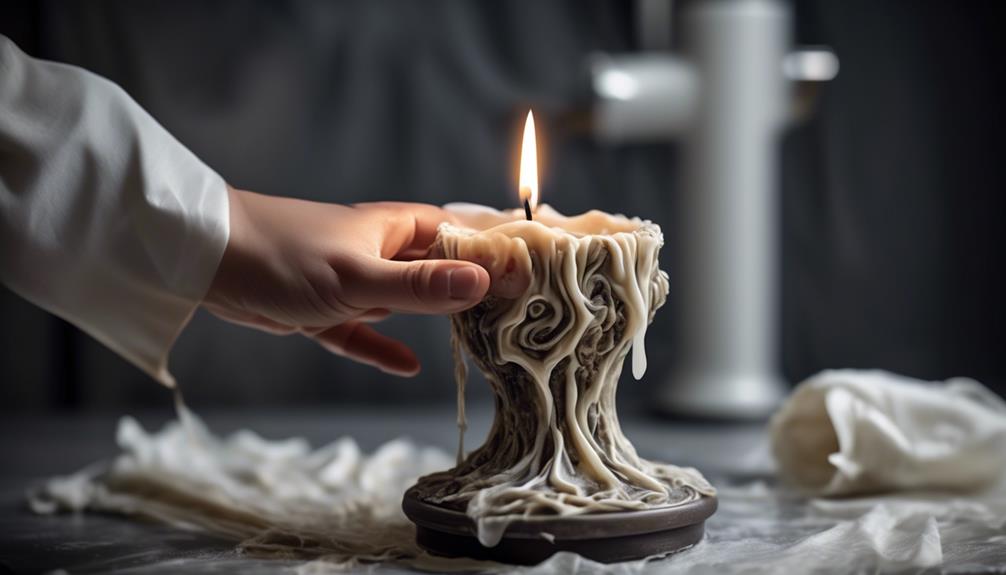Hello there!
Have you ever had the unfortunate experience of getting candle wax stains on your favorite clothes? Well, fret not, because we’ve got you covered with a simple solution.
Removing candle wax stains from clothes can be a breeze if you follow our tried and tested methods. From freezing the wax to treating residual stains, we’ll show you step-by-step how to restore your garments to their former glory.
No more stressing over those pesky wax stains ruining your wardrobe! So, let’s dive in and learn how to banish those stubborn stains once and for all. Grab your tools and let’s get started!

Key Takeaways
- Place a clean white cloth over the stained area and press down to absorb excess wax.
- Use an iron and a brown paper bag to melt and absorb the remaining wax.
- Consider freezing the stained garment and gently scraping off the hardened wax.
- Blot the stained area with a clean white cloth using the appropriate solvent.
Preparing the Stained Garment
To prepare the stained garment, we’ll need a few basic supplies and a clean work area. Before attempting to remove the candle wax stain, it’s important to blot any excess wax using effective blotting techniques.
Start by placing a clean white cloth over the stained area and gently press down. This will help absorb as much wax as possible. Avoid rubbing or scrubbing, as this can push the wax deeper into the fabric.
Once the excess wax has been removed, it’s time to explore alternative stain removal methods. One effective method is to use an iron and a brown paper bag. Place the bag over the stained area and apply heat with the iron. The heat will melt the wax, and the paper bag will absorb it. Repeat this process until the stain is gone.
Freezing the Wax
One effective way to remove candle wax stains from clothes is by freezing the wax. The heat vs. cold technique is often used to tackle wax stains, and freezing is a popular method.

To begin, place the stained garment in a plastic bag and seal it tightly. Then, put it in the freezer for a few hours or until the wax becomes hard and brittle.
Once frozen, take out the garment and gently scrape off the wax using a butter knife or credit card. Be careful not to damage the fabric.
If any residue remains, you can try using a solvent specifically designed for removing wax stains. Make sure to choose the right solvent based on the fabric type, and always follow the instructions on the label.
Scraping off the Hardened Wax
Now that the wax has hardened, it’s time to start scraping it off. Use a dull knife or the edge of a credit card to gently remove as much wax as possible.
Be careful not to apply too much pressure or you may damage the fabric.
Take your time and work slowly to avoid causing further damage to your clothes.
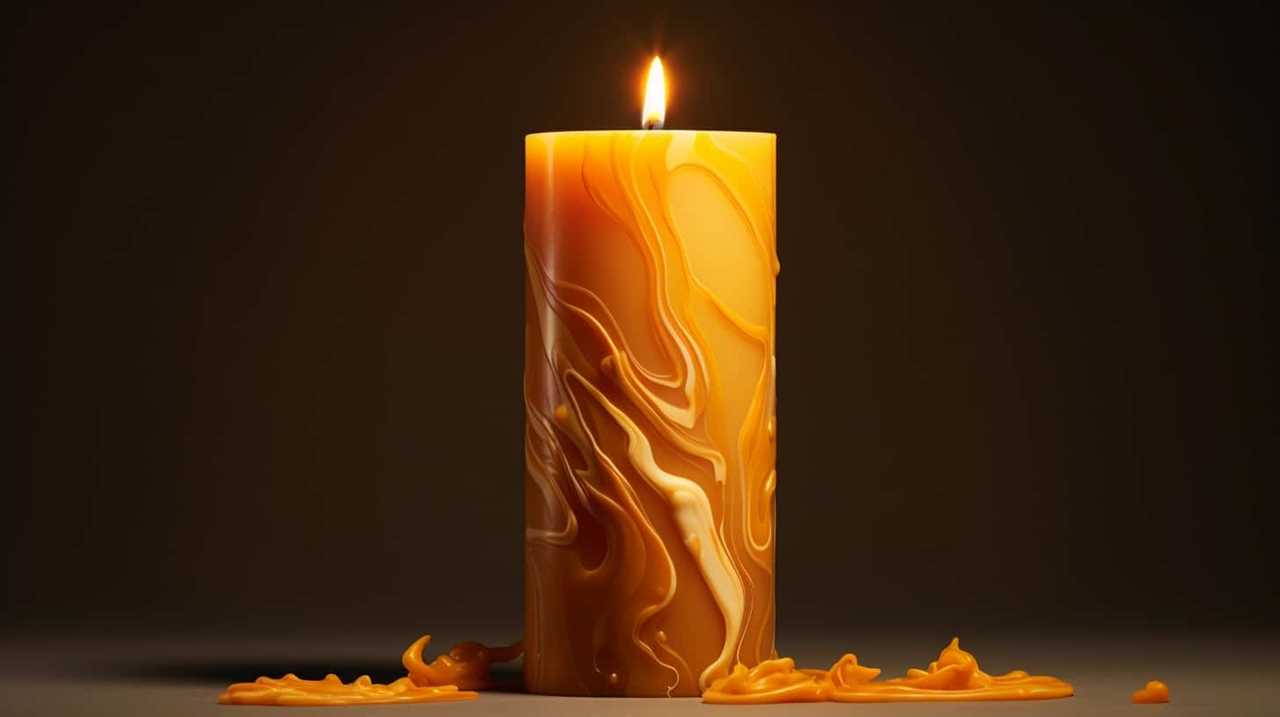
Effective Scraping Techniques
We found that using a credit card is an effective way to scrape off the hardened wax from clothes.
Here are some effective scraping techniques to help you remove candle wax stains while preventing further damage:
- Credit Card: Gently scrape the hardened wax using the edge of a credit card. Be careful not to press too hard to avoid tearing or stretching the fabric.
- Butter Knife: Use the dull side of a butter knife to scrape off the wax. Again, be gentle and avoid putting too much pressure on the fabric.
- Plastic Spatula: A plastic spatula can also be used to scrape off the wax. Make sure to choose a spatula with a smooth edge to prevent any additional damage.
Preventing Further Damage
To prevent further damage when scraping off the hardened wax, it’s important to employ gentle techniques that minimize the risk of tearing or stretching the fabric. Start by placing the garment in the freezer for about 30 minutes. This will harden the wax, making it easier to scrape off without causing any damage.
Once the wax is hardened, use a blunt object, like a spoon or a dull knife, to gently scrape off as much wax as possible. Be careful not to apply too much pressure, as this can lead to fabric damage.

If the wax leaves behind any residue, you can place a brown paper bag or a clean cloth on top of the stain and iron over it on a low heat setting. The heat will help transfer the wax from the fabric to the paper or cloth. Remember to protect delicate fabrics by using a lower heat setting and avoiding direct contact between the iron and the fabric.
Blotting the Stained Area
When it comes to blotting the stained area, there are a few important points to consider.
First, you can try using the heat vs. cold technique to remove the wax. Applying heat can help melt the wax, making it easier to blot away. Alternatively, you can try the cold technique by freezing the wax and then scraping it off.
Second, choosing the right solvent is crucial. Depending on the fabric, you may need to use rubbing alcohol, dish soap, or a stain remover to dissolve the wax.
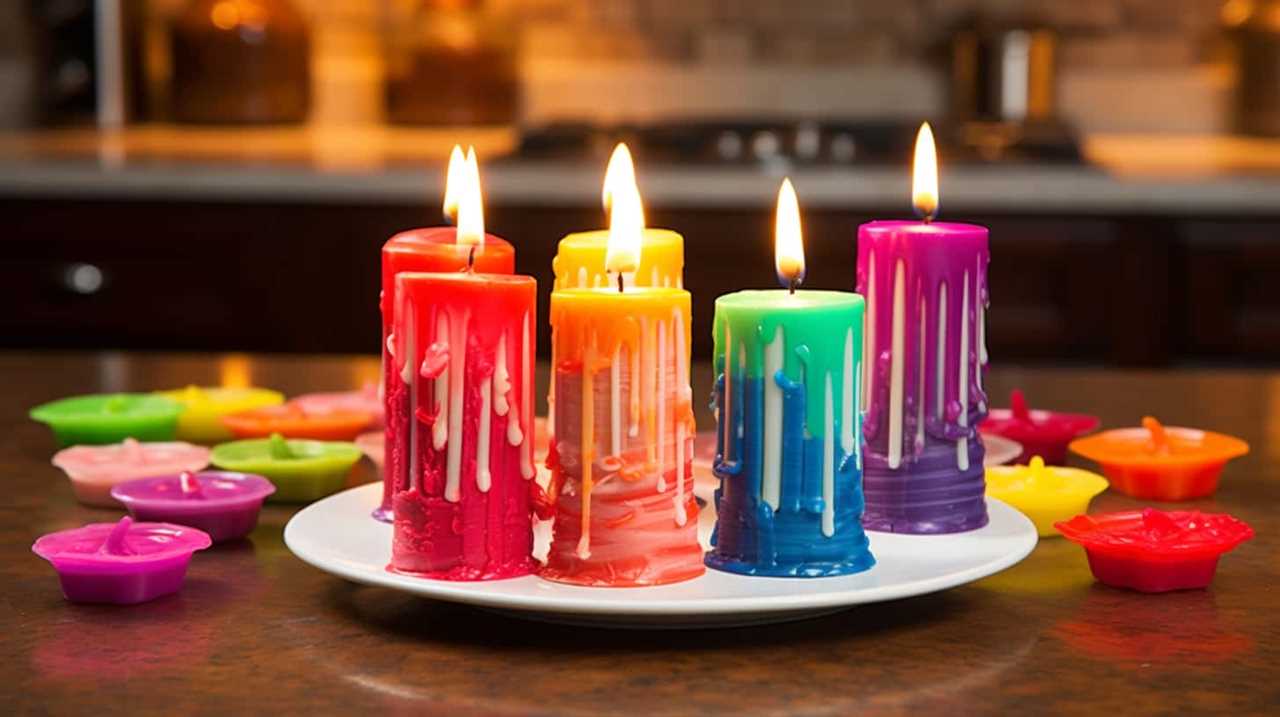
Heat Vs. Cold Technique
For removing candle wax stains from clothes, our go-to technique involves applying heat or cold and then gently blotting the stained area. When it comes to choosing between heat and cold, both methods can be effective in removing wax stains. Here are the advantages of each technique:
- Heat Technique:
- Using hot water: Pouring hot water directly on the wax stain helps to melt and loosen the wax, making it easier to remove.
- Quick and efficient: Applying heat speeds up the process of removing the wax, saving you time and effort.
- Works well on delicate fabrics: Heat is generally safe to use on most fabrics, including delicate ones.
- Cold Technique:
- Alternative methods: Placing the stained garment in the freezer or using an ice pack can harden the wax, making it brittle and easier to scrape off.
- Minimizes spreading: Cold temperatures prevent the wax from spreading further into the fabric fibers.
- Suitable for heat-sensitive fabrics: Cold technique is ideal for fabrics that may be damaged by heat, such as silk or synthetic materials.
Choosing the Right Solvent
After determining whether to use the heat or cold technique for removing candle wax stains from clothes, we can now focus on choosing the right solvent and blotting the stained area. When it comes to removing wax from delicate fabrics, it is crucial to choose a solvent that will effectively dissolve the wax without damaging the material. Here are three common solvents that work well for this purpose:
| Solvent | Description | Suitable Fabrics |
|---|---|---|
| Rubbing Alcohol | This solvent is effective in breaking down wax and evaporates quickly. | Cotton, polyester, nylon |
| Dishwashing Soap | Mild dishwashing soap can be used to dissolve the wax and remove stains. | Silk, wool, rayon |
| White Vinegar | Vinegar is a natural solvent that helps loosen the wax and remove any residue. | Linen, satin, chiffon |
To use these solvents, simply apply a small amount onto a clean cloth and gently blot the stained area. It is important to avoid rubbing, as this can push the wax further into the fabric. Repeat the process until the stain is fully removed.
Pre-Treating With Detergent
After choosing the right solvent, we can now move on to pre-treating the stained area with detergent. This step is crucial in removing candle wax stains from clothes effectively. To ensure success, follow these expert tips:

- Blot the Stained Area: Gently blot the wax stain using a clean cloth or paper towel. This will help remove any excess wax and prevent it from spreading further.
- Heat vs. Cold Technique: For heat-resistant fabrics, place a paper towel over the stain and iron on a low setting. The heat will melt the wax, allowing it to transfer onto the paper towel. For delicate fabrics, use the cold technique instead.
- Recommended Cleaning Products: Apply a small amount of liquid detergent directly to the stained area. Rub it gently, focusing on the wax residue. Allow the detergent to penetrate the fabric for a few minutes before proceeding to the next step.
Applying a Stain Remover
To remove candle wax stains from clothes, we can begin by applying a stain remover using a small amount of detergent and warm water. This step is crucial in breaking down the wax and loosening it from the fabric fibers. When choosing a stain remover, it’s important to consider the type of fabric and the nature of the stain. For delicate fabrics, it’s recommended to use a solvent-based stain remover. On the other hand, for washable fabrics, a detergent-based stain remover will work effectively.
It’s also important to note that when treating candle wax stains, it’s best to use the heat vs. cold technique. Applying heat, such as using an iron, helps to melt the wax, making it easier to remove from the fabric. However, be cautious and always use a protective cloth between the iron and the fabric to avoid any damage.
Pre-Treating the Stain
We can start by using a pre-treatment solution to tackle the candle wax stain on our clothes. Pre-soaking fabrics in a stain remover can effectively break down the wax and make it easier to remove.
Here are three natural stain removers that can be used for pre-treating the stain:

- Vinegar: Dilute vinegar with water and apply it to the stained area. Let it sit for a few minutes before gently scrubbing the stain.
- Baking soda: Make a paste using baking soda and water, then apply it to the stain. Leave it on for about 15 minutes before rinsing.
- Lemon juice: Squeeze fresh lemon juice onto the stain and let it sit for a few minutes. Rinse the fabric with cold water.
Washing the Garment
First, we’ll gently wash the garment to remove any remaining wax residue. When washing the garment, it’s important to consider the method that will be most effective in removing the stain.
Heat and cold methods can both be used for stain removal. For heat methods, you can place a brown paper bag or paper towel over the stain and iron it on a low setting. The heat will help melt the wax, allowing it to be absorbed by the paper.
Cold methods involve placing the garment in the freezer for a few hours until the wax hardens. Once hardened, you can scrape off the wax with a blunt knife.
To prevent future wax stains, it’s recommended to use candle holders or cover the candles to avoid any dripping.

Checking for Any Remaining Stains
After washing the garment, we’ll carefully inspect it to check for any remaining candle wax stains. It’s important to thoroughly examine the fabric to ensure that all traces of wax have been removed.
Here are some steps to follow when checking for any lingering stains:
- Check for discoloration: Look closely at the fabric to see if there are any areas that appear discolored or darker than the rest of the garment. This could indicate that wax residue is still present.
- Feel for any waxy residue: Run your fingers over the fabric to check for any sticky or waxy residue. If you feel any, it means that some wax may still be present.
- Perform blotting techniques: If you find any remaining stains, try using blotting techniques to remove them. Place a clean cloth or paper towel over the stain and gently press down to absorb the wax. Repeat this process until the stain is gone.
Treating Residual Stains
Now that we’ve checked for any remaining stains, let’s discuss how to treat residual wax stains on clothes.
There are various stain removal techniques that can be used depending on the fabric and the severity of the stain.

Additionally, it’s important to take steps to prevent future wax stains and to use recommended cleaning products for effective removal.
Stain Removal Techniques
To effectively treat residual stains on clothes, we employ various stain removal techniques. These methods are crucial in preventing re-staining and ensuring that your clothes look as good as new.
Here are some alternative stain removal methods that you can try:
- Ice Method: Place ice cubes in a plastic bag and apply it to the wax stain until it hardens. Then, gently scrape off the hardened wax using a blunt knife or spoon.
- Heat Method: Lay a clean cloth over the wax stain and iron it on a low heat setting. The heat will melt the wax, and the cloth will absorb it.
- Dishwashing Liquid Method: Apply a small amount of dishwashing liquid directly to the stain and gently rub it in. Rinse with cold water and repeat if necessary.
Preventing Future Wax Stains
To prevent future wax stains, we recommend treating residual stains promptly and employing proper stain removal techniques.

Residual stains can still pose a risk of re-soiling your clothes if left untreated. To start, scrape off any excess wax using a dull knife or spoon.
Then, place a paper towel or brown paper bag over the stained area and apply a warm iron on low setting. The heat will help transfer the wax onto the paper. It’s important not to use high heat as it can damage the fabric.
Additionally, for long term stain prevention strategies, consider using a stain repellent spray on your clothes before wearing them. This will create a protective barrier against wax and other stains.
Regularly washing your clothes with a quality stain remover can also help prevent future stains from setting in.
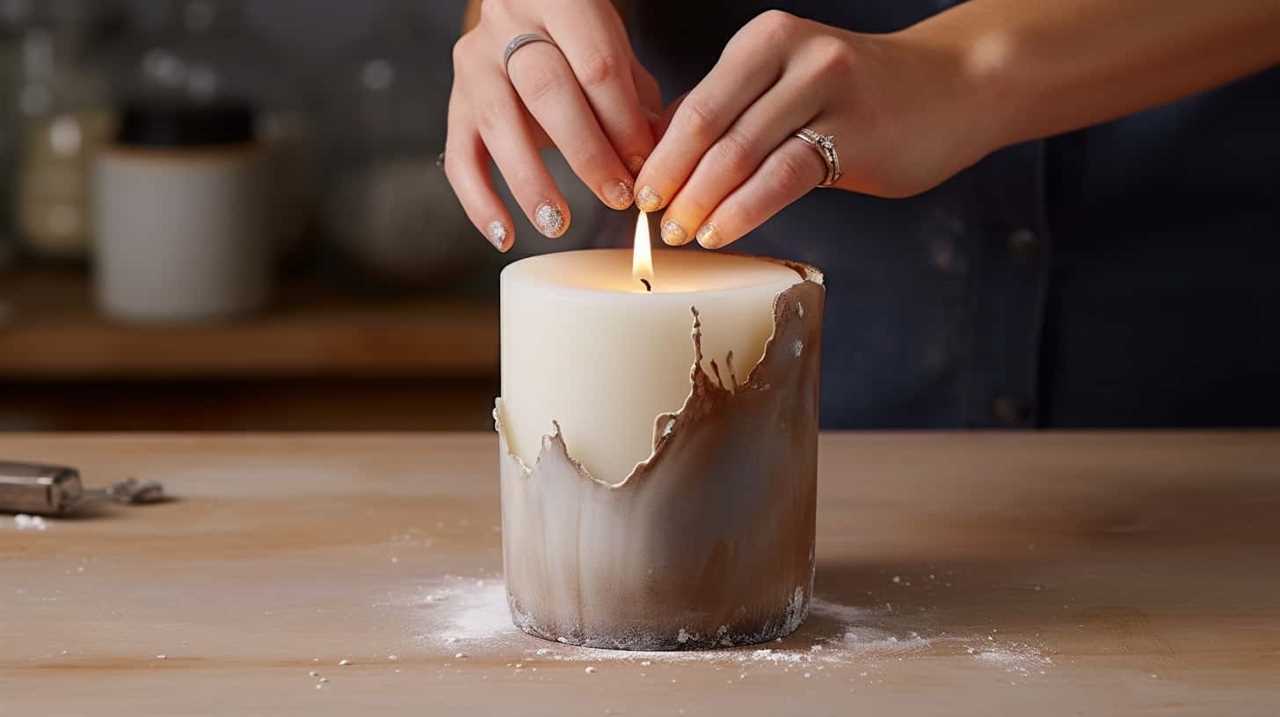
Recommended Cleaning Products
After scraping off any excess wax, we recommend using a warm iron and a paper towel or brown paper bag to transfer the remaining wax onto the paper. This will help prevent further damage to your clothing.
In addition to this method, there are several recommended cleaning products that can effectively treat residual wax stains:
- Goo Gone: This product is specifically designed to remove sticky substances like candle wax. Simply apply it to the stain, let it sit for a few minutes, and then gently scrub with a soft cloth.
- Rubbing Alcohol: Dabbing the stain with rubbing alcohol can help break down the wax and make it easier to remove. Remember to test it on a small, inconspicuous area first to ensure it doesn’t damage the fabric.
- Dish Soap: Mix a few drops of dish soap with warm water and apply it to the stain. Gently rub the fabric together to work the soap into the wax, then rinse thoroughly.
By using these recommended cleaning products, you can effectively treat residual wax stains and prevent further damage to your clothes.
Now let’s move on to the next section, where we’ll discuss using heat to remove stubborn stains.
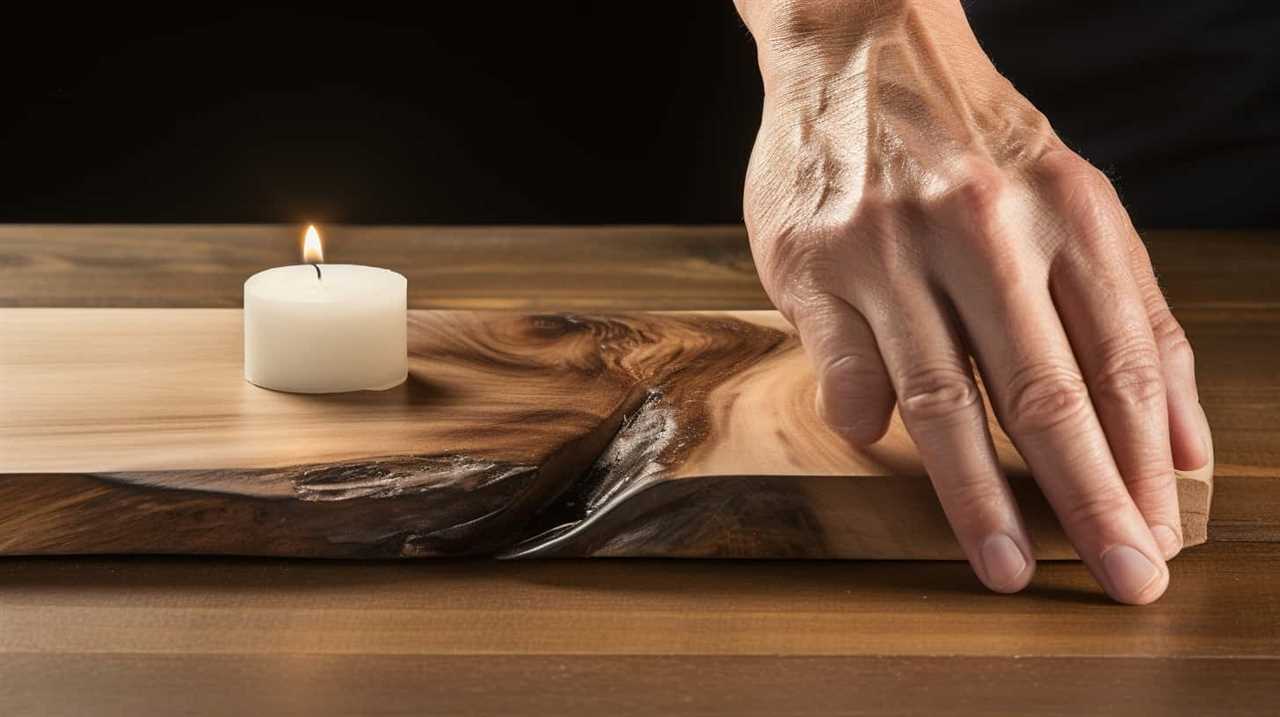
Using Heat to Remove Stubborn Stains
One effective method we’ve found for removing stubborn candle wax stains from clothes is using heat. Heat application helps to soften the wax, making it easier to remove from the fabric.
To use this method, start by placing a clean white cloth or paper towel over the stained area. Then, apply heat to the cloth using an iron on a low setting. Move the iron back and forth over the cloth, being careful not to press too hard.
As the wax melts, it will transfer onto the cloth, removing wax residue from the garment. Remember to replace the cloth or paper towel as needed to prevent re-depositing the wax onto the fabric.
Once the wax has been removed, treat any remaining stain with a stain remover and wash the garment as usual.
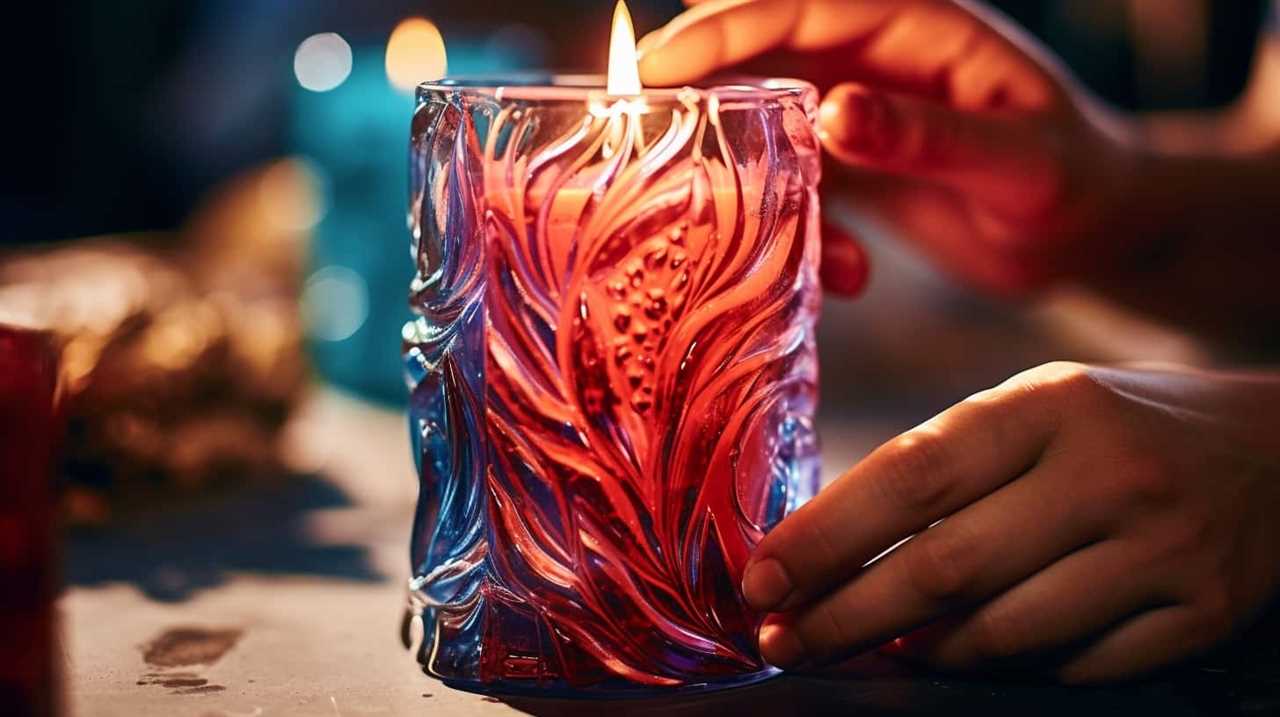
Repeating the Process if Necessary
If the wax stain persists, we may need to repeat the process. Don’t worry, removing stubborn stains is possible with a little persistence. Here are three steps to help you tackle those pesky candle wax stains:
- Assess the stain: Take a close look at the affected area to determine if any wax residue remains. If so, move on to the next step.
- Repeat the previous steps: Apply heat and scrape off as much wax as possible using a butter knife or credit card. Then, place a paper towel or brown paper bag over the stain and iron it on a low heat setting. This will transfer the remaining wax onto the paper.
- Treat any residual stains: If a stain still persists, apply a stain remover or a mixture of dish soap and warm water to the affected area. Gently rub the solution into the stain and let it sit for a few minutes before washing as usual.
Preventing Future Wax Stains
To prevent future wax stains, we should be proactive in taking measures to avoid accidents.
One effective way to prevent future damage is by using candle holders or trays. These accessories provide a stable base for candles, reducing the risk of them tipping over and causing wax spills.
Additionally, placing candles away from areas with high traffic or where they can easily be knocked over can help prevent accidents.

Another long-term stain prevention technique is to avoid placing candles directly on delicate or easily stained surfaces. By using heat-resistant mats or coasters under candles, any wax spills can be contained and easily cleaned up.
Regularly trimming candle wicks can also prevent excessive dripping and reduce the chances of wax stains.
Frequently Asked Questions
Can I Use a Hairdryer to Remove Candle Wax Stains From Clothes?
Using a hairdryer to remove candle wax stains: Does it really work? Can it damage the fabric? Yes, it can work by melting the wax and absorbing it with a paper towel. However, be cautious as excessive heat may damage certain fabrics.
Is It Safe to Use Bleach on Colored Garments to Remove Candle Wax Stains?
We don’t recommend using bleach on colored garments to remove candle wax stains. Instead, try using bleach alternatives or natural stain removal methods that are safer for your clothes.

How Long Should I Freeze the Wax-Stained Garment Before Scraping off the Hardened Wax?
First, we need to freeze the wax-stained garment until the wax hardens. Then, scrape off the hardened wax gently. Remember to be patient and take your time.
Can I Use Any Type of Stain Remover to Treat Candle Wax Stains?
Using vinegar can effectively remove candle wax stains from clothes. Additionally, using an iron can also be effective in removing these stains. However, it is important to follow proper instructions and precautions when using these methods.
What Should I Do if the Candle Wax Stain Doesn’t Completely Come Out After Washing the Garment?
If the candle wax stain doesn’t come out after washing, there are alternative stain removal methods to try. If all else fails, professional dry cleaning options may be the best solution.
Conclusion
So there you have it, folks! With these simple steps, you can wave goodbye to those pesky candle wax stains on your favorite clothes. No more fretting over ruined outfits or expensive dry cleaning bills.

Just remember to keep your cool, scrape off the hardened wax, blot away the stains, and treat them with a stain remover. And if those stubborn stains still linger, don’t be afraid to apply some heat.
Now go forth, laundry warriors, and conquer those wax stains like the experts you are!










